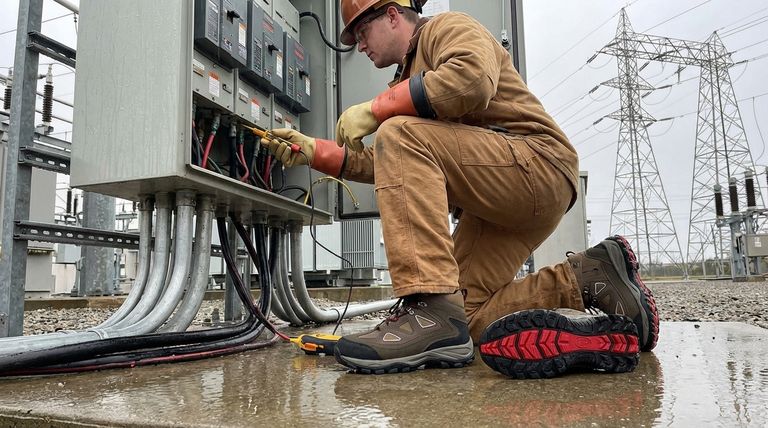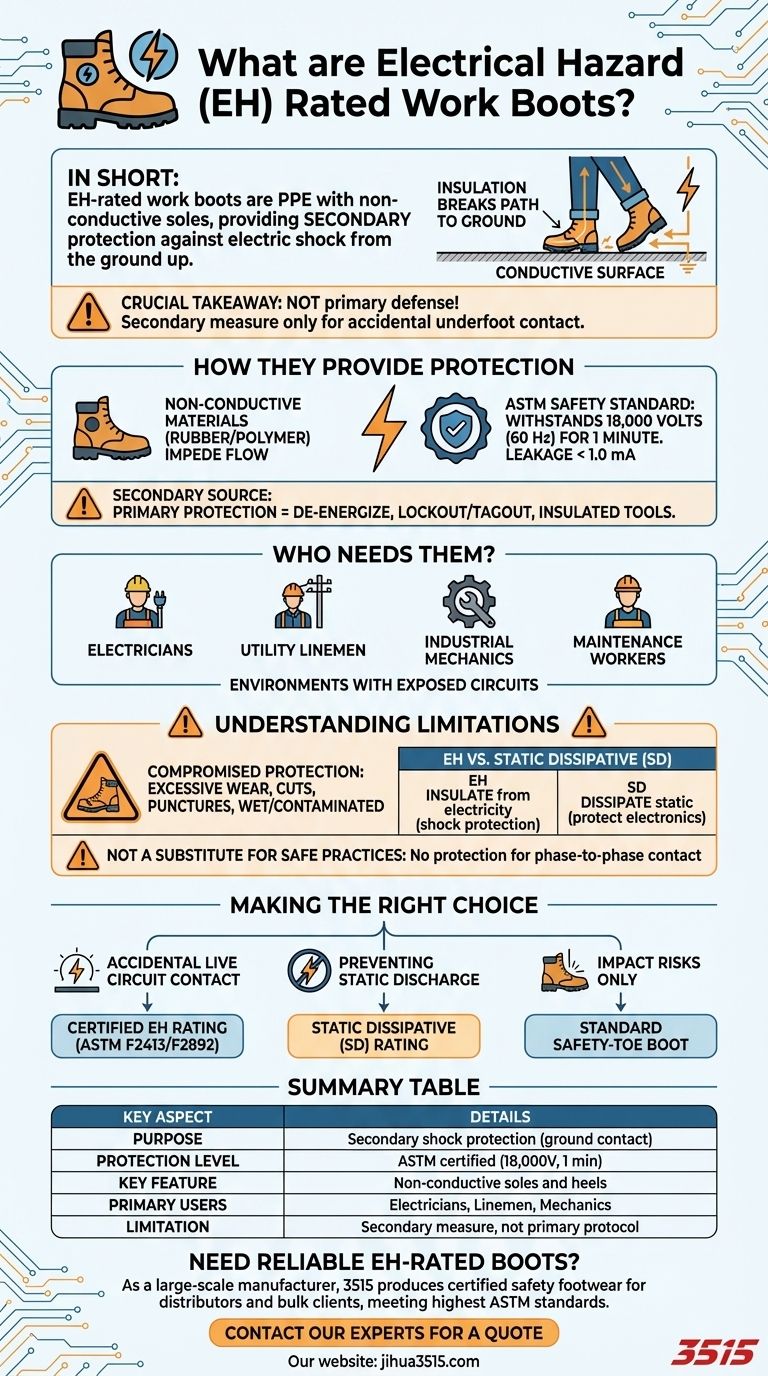In short, Electrical Hazard (EH) rated work boots are a form of personal protective equipment (PPE) designed with non-conductive, shock-resistant soles and heels. Their purpose is to provide a secondary source of protection against accidental contact with live electrical circuits, reducing the risk of electric shock from the ground up.
The crucial takeaway is that EH-rated boots are not a primary defense for working on or near energized equipment. They are a secondary measure designed to insulate you from the ground in case you accidentally step on a live wire or come into contact with an energized conductor.

How EH-Rated Boots Provide Protection
EH-rated boots function as an insulator between your body and the ground. This breaks the path that an electrical current would otherwise take through you if you made accidental contact with a live circuit.
The Principle of Non-Conductivity
The entire sole and heel of an EH-rated boot are constructed from materials that do not conduct electricity well, such as specific rubber and polymer compounds. This construction is designed to impede the flow of electricity.
The ASTM Safety Standard
For a boot to carry the EH rating, it must be tested and certified to meet a specific standard from the American Society for Testing and Materials (ASTM). The standard requires the footwear to withstand the application of 18,000 volts at 60 Hz for one minute with no current flow or leakage current in excess of 1.0 milliampere.
A Secondary Source of Protection
It is critical to understand that EH-rated footwear is a secondary line of defense. Primary protection involves de-energizing equipment, using lockout/tagout procedures, and employing insulated tools. These boots are for mitigating risk from accidental, underfoot contact only.
Who Needs EH-Rated Footwear?
This type of protection is essential for anyone working in an environment where they could be exposed to live electrical conductors, circuits, or equipment.
High-Risk Professions
This includes professions such as electricians, utility linemen, industrial mechanics, and maintenance workers who routinely work with or near high-voltage apparatus.
Environments with Exposed Circuits
Any worker in construction, manufacturing, or service industries who operates near potentially damaged or exposed wiring should consider EH-rated boots a mandatory part of their PPE.
Understanding the Limitations and Trade-offs
While vital, the protection offered by EH-rated boots is not absolute. Understanding their limitations is key to using them safely and effectively.
Protection Can Be Compromised
The insulating properties can be significantly reduced or eliminated by excessive wear, deep cuts, or punctures in the sole. Furthermore, if the boots are wet or contaminated with conductive materials like metal shavings, their effectiveness is compromised.
EH vs. Other Safety Features
An EH rating is a specific feature, separate from others. A boot can be EH-rated and also have a safety toe (steel, composite, or alloy), in which case it falls under the ASTM F2413 standard. A soft-toe boot with an EH rating falls under the ASTM F2892 standard.
Not a Substitute for Safe Practices
Never assume EH-rated boots make you immune to electric shock. They provide no protection if you make phase-to-phase or phase-to-grounded-conductor contact with other parts of your body. Always follow established electrical safety protocols.
EH vs. Static Dissipative (SD)
Do not confuse EH with Static Dissipative (SD) footwear. EH boots insulate you from electricity. SD boots are designed to do the opposite: they safely dissipate static electricity buildup from your body to the ground to protect sensitive electronic equipment from damage.
Making the Right Choice for Your Goal
Selecting the correct footwear requires a clear understanding of your work environment's specific hazards.
- If your primary focus is protection from accidental contact with live electrical circuits: You must select footwear with a certified EH rating that meets ASTM standards.
- If your primary focus is preventing static discharge around sensitive electronics: You need footwear with a Static Dissipative (SD) rating, not an EH rating.
- If your work involves heavy objects and impact risks without electrical hazards: A standard safety-toe boot without an EH rating will meet your needs.
Choosing footwear based on the specific, identified hazards of your job is a fundamental step in ensuring your personal safety.
Summary Table:
| Key Aspect | Details |
|---|---|
| Purpose | Secondary protection against electric shock from ground contact. |
| Protection Level | ASTM certified to withstand 18,000 volts for 1 minute. |
| Key Feature | Non-conductive soles and heels to insulate the wearer. |
| Primary Users | Electricians, linemen, industrial mechanics, maintenance workers. |
| Limitation | A secondary safety measure; not a substitute for primary protocols. |
Need reliable EH-rated work boots for your team?
As a large-scale manufacturer, 3515 produces a comprehensive range of certified safety footwear for distributors, brand owners, and bulk clients. We ensure your workforce is equipped with PPE that meets the highest ASTM standards for electrical hazard protection.
Contact our experts today to discuss your EH-rated boot requirements and get a quote.
Visual Guide

Related Products
- Safety Footwear Wholesale Manufacturer for Custom OEM/ODM Production
- Premium KPU Injection Athletic Style Safety Shoes
- Wholesale Safety Footwear Manufacturer for Bulk & Custom OEM Orders
- Custom Wholesale Leather Safety Boots Direct Factory Manufacturing
- Premium Flame-Retardant Waterproof Safety Boots and Shoes
People Also Ask
- Do snake bite boots work? Your Ultimate Guide to Effective Snake Bite Protection
- Is it normal to wear shoes in the house? A Guide to Hygiene, Comfort & Culture
- What are the differences between steel toe, composite toe, and alloy toe Wellington boots? Choose the Right Safety Toe for Your Job
- How long can you wear safety boots? The Lifespan is Determined by Wear, Not Time
- How do safety shoes contribute to cost savings for companies? A Strategic Investment in Risk and Cost Management



















